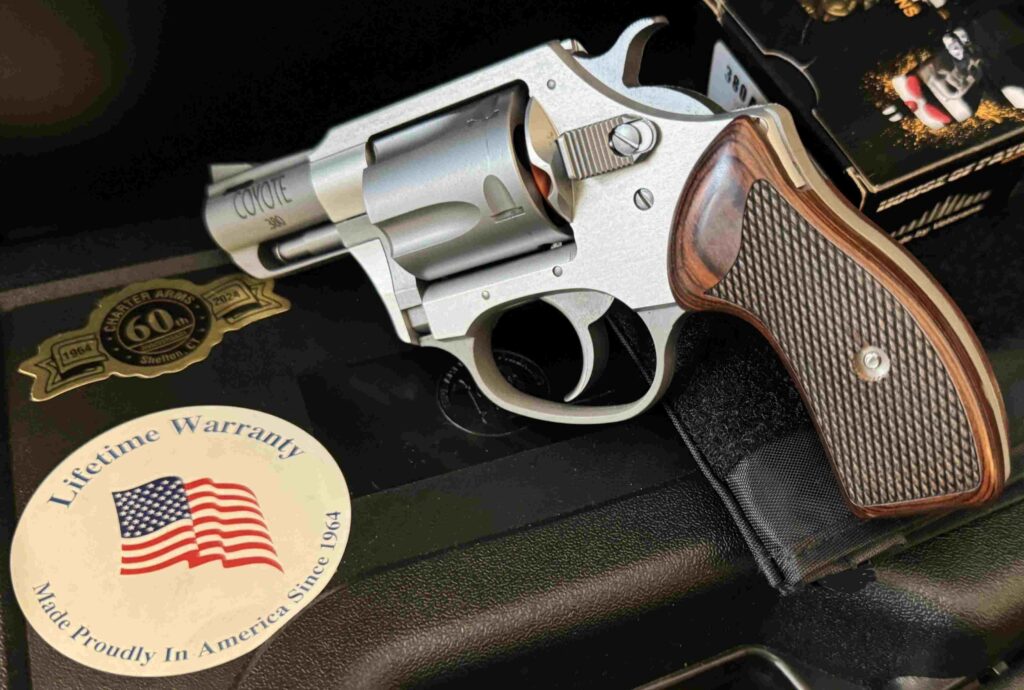This year marks the 60th Anniversary of Charter Arms. One of America’s newer gun manufacturers, it was founded in 1964, by Douglas McClennahan, a young gun designer who had previously worked for Colt, High Standard, and Ruger. He set out on his own to create a handgun that was high-quality, reliable, and affordable. The result was the “Undercover,” a .38 Special, 5-shot, DA revolver, that had a solid steel frame, yet weighed only 16 oz. It had fewer moving parts than its competitors, and included a unique hammer block system that protected against unintentional discharges. Long-time friend David Ecker came on board in 1967, and the Undercover became the platform on which a successful line of firearms was built. They are 100% American made, with American Parts, and American owned, plus have a lifetime warranty.
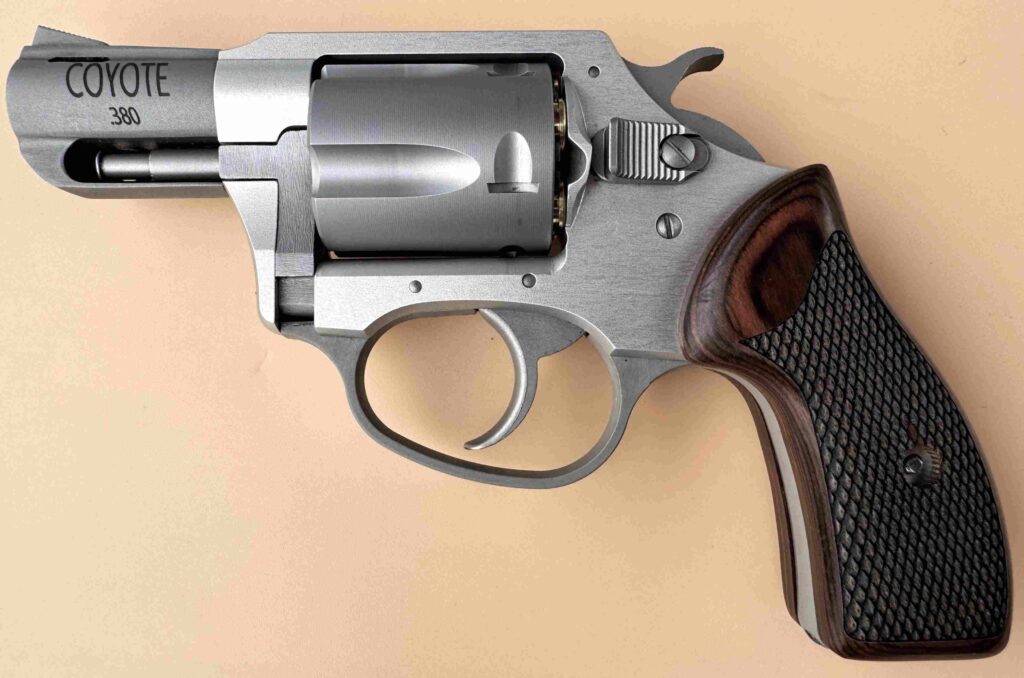
With a frame manufactured from 7075 aluminum and a barrel and cylinder made from 416 stainless-steel, the Coyote has an empty weight of just 14 oz.
Introducing the Coyote
One of Charter Arm’s new revolvers for 2024 is the Coyote, it’s a small-frame, double-action revolver, with a 2-inch barrel, and is chambered in .380 ACP. Although this cartridge was created for semi-automatic pistols, this revolver takes advantages of the rounds milder-shooting attributes, coupled with its 14 oz. weight. The barrel has 8-groove rifling for improved accuracy and velocity, plus it’s ported, to cut down on muzzle flip and recoil.
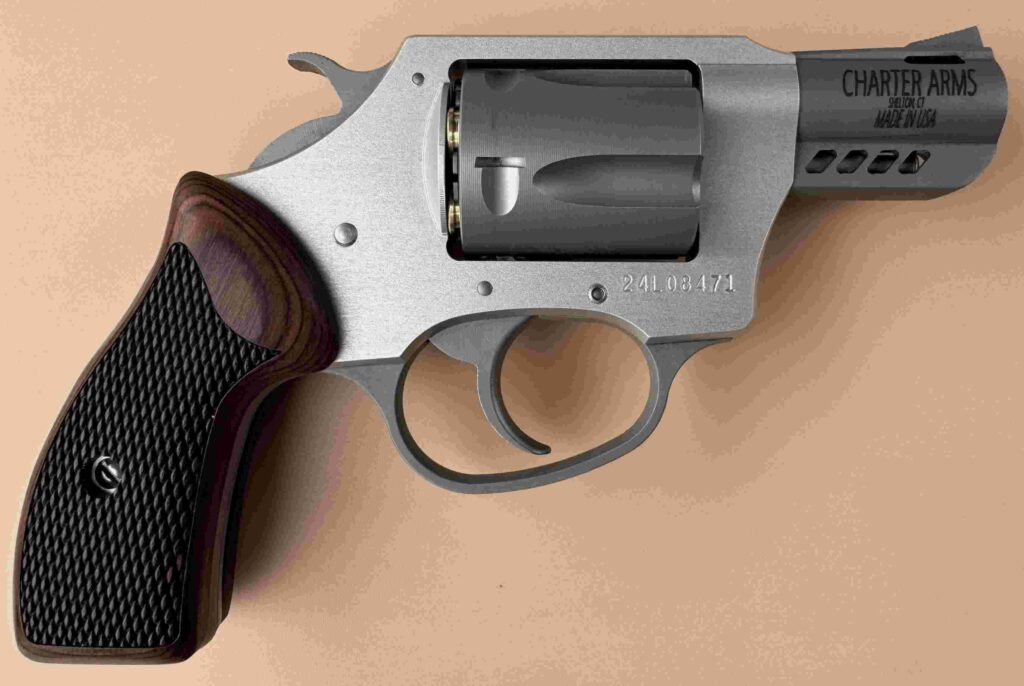
The barrel underlug on the Coyote has four diamond cuts to reduce weight, and the grips/stocks are made of checkered rosewood.
Charter revolvers have solid frames; unlike most other small-frame wheelguns that have side-plates. The action is fitted in through the bottom and rear of the frame, then the grip-frame/trigger guard assembly is fitted into the frame. This construction strengthens the frame, which is fabricated from 7075 aluminum. The barrel, cylinder, crane, other component parts are formed from 416 stainless-steel. My test gun (Model 53802) has an anodized finish on the frame, while the stainless-steel components, and grip frame have a contrasting darker, matte finish. Two versions are available with a pink or lavender anodized frame, and the stainless-steel parts are highly polished. All Coyote models have checkered rosewood grips. The front sight is a serrated ramp, while the rear sight is a fixed square-notch in the topstrap. To reduce weight, the barrel underlug/ejector rod shroud has four diamond cuts. When the trigger is pulled, the cylinder locks in the breech-face, on the crane/yoke; aided by the hand and cylinder bolt. The cylinder release latch is pushed forward to unlock the cylinder for loading.
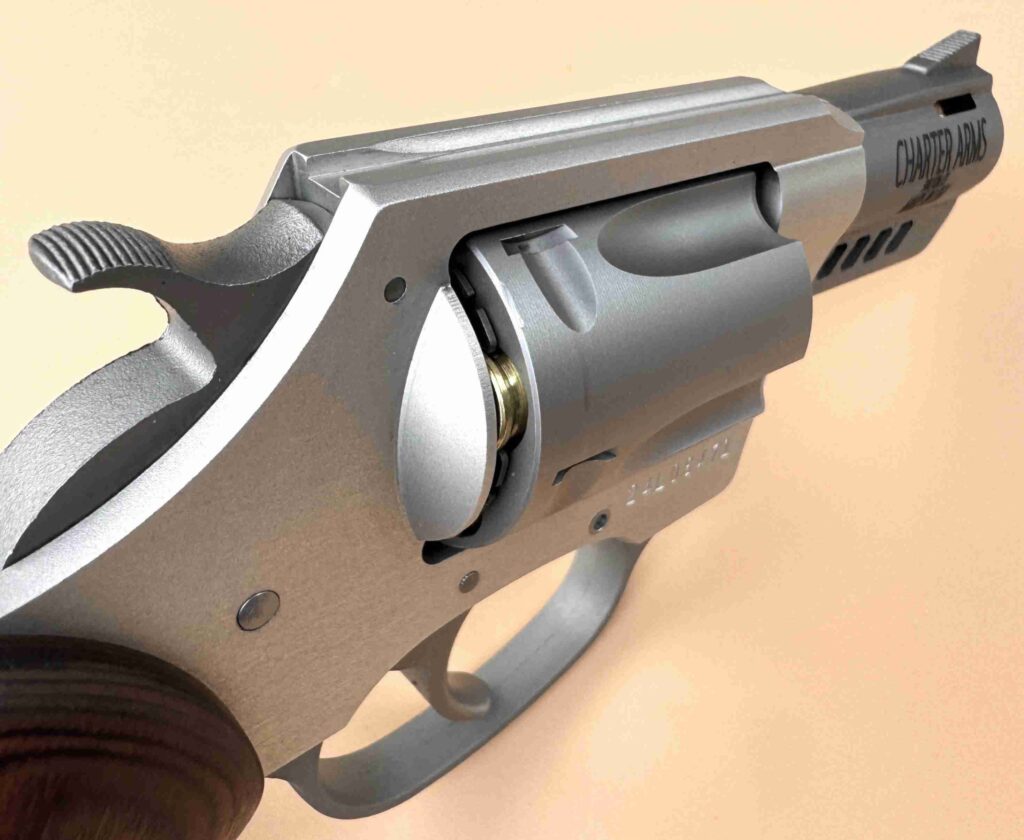
This view shows the fixed sights on the Coyote; you can also see the barrel port, plus the serrated hammer spur.
Revolvers like Charter’s Pitbull in .45 ACP don’t require moon clips for cartridge case ejection, but that isn’t the case with the Coyote. The cylinder chambers are cut so the .380 ACP cartridges headspace on the case mouth; but for proper case ejection, two TK Custom moon clips are provided. You can fire the revolver without the clips, but the empty cases have to be extracted by hand, and primer ignition is not 100%. The single action (SA) trigger pull was a crisp 4-lbs. 8.6 oz., while the double action (DA) pull was fairly smooth, with a weight of 11-lbs. 8 oz. The trigger is smooth-faced and 0.25-inches wide; the exposed hammer has a serrated spur.
My sample Coyote came in a black plastic carrying case with a foam-rubber interior lining. Besides the gun, inside was a safety trigger lock, owner’s manual, the moon clips, a catalog, and other printed matter. Charter Included a handy “Coyote Shell Remover,” which makes removing the empty .380 ACP cases from the moon clips a snap. This tool is sold as an accessory, as are extra moon-clips. A once-over inspection of the Coyote found the fit and finish was above average for a handgun in its price-point. Markings on the little wheelgun are minimal; the serial number is on the right side of the frame, and on the left side of the barrel in COYOTE .380, while on the opposite side is CHARTER ARMS Shelton, CT MADE IN USA.
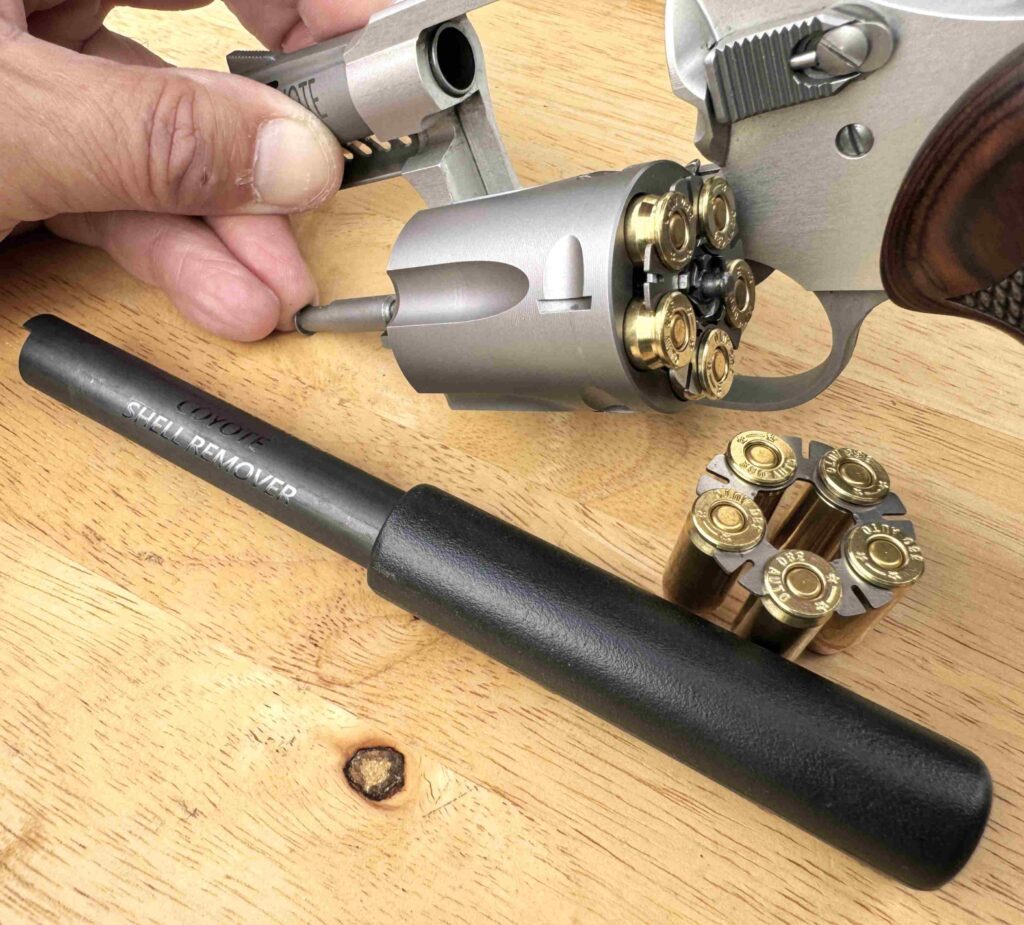
The Coyote has a swing-out cylinder and uses moon-clips with the .380 cartridges for proper ejection; an optional shell remover is definitely worthwhile.
Time for the T&E
My .380 ACP test ammunition came from several sources. Black Hills supplied their 60 gr. Honey Badger load; that has a solid copper bullet with an X-shaped and fluted nose, to impart energy to the target. Doubletap sent me a load that has an 80 gr. Barnes TAC-HP solid copper bullet. Federal provided their Premium HST “Micro” load, which carries a 99 gr. HST-JHP bullet. A manufacturer that I recently became acquitted with called House of Payne (HOP) Munitions, supplied their 90 gr. JHP load, along with 95 gr. FMJ practice cartridges.
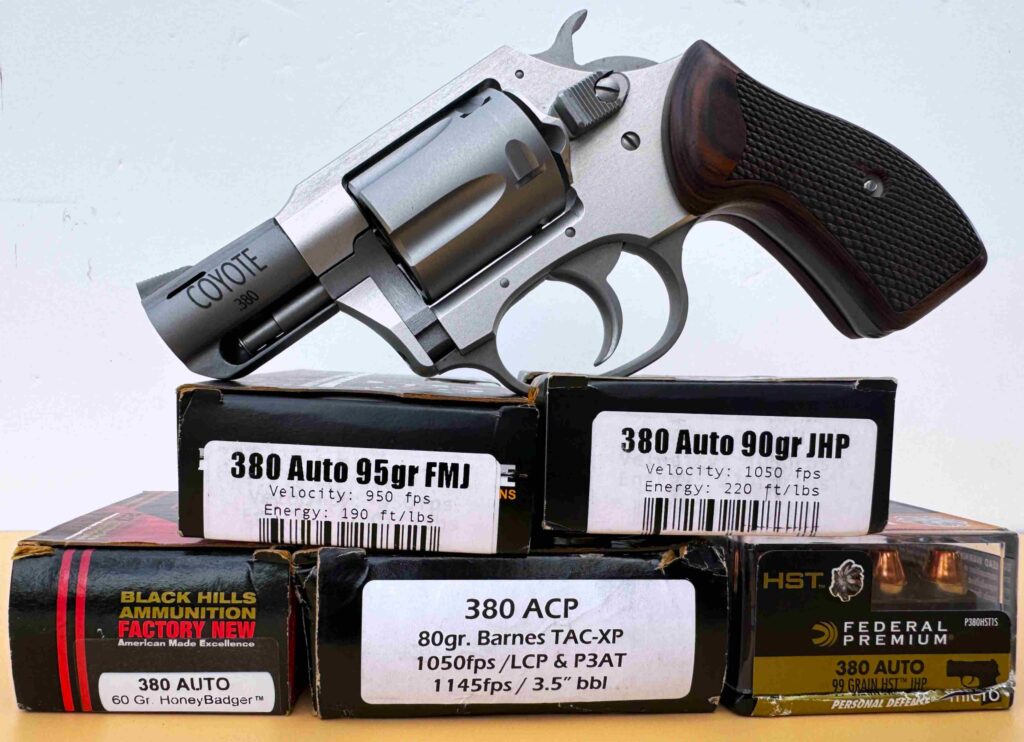
Test .380 ACP ammunition came from four sources; the two boxes at the top are from House of Payne (HOP) Munitions.
The evaluation began with a chronographing session to see what kind of bullet velocities the Coyotes 2-inch, ported barrel would produce. Most impressive was the HOP 90 gr. JHP; the bullet speed averaged 1,119 FPS; velocity figures for the other test loads are in the performance table. Next, was the accuracy potential evaluation. Shooting was done single action, from the bench, using a sandbag rest; distance to the target was 10 yards. Three 5-shot groups were fired with each of the .380 ACP test cartridges. My tightest 5-shot group measured 1.37-inches, and was made using the HOP 95 gr. FMJ load. Second place went to the Federal HST load, with a 1.56-inch group. Overall group average during the accuracy test was 2.106-inches.
Earlier, I had my wife Teresa try some dry-firing with the Charter Coyote; she has arthritic hands, but she was able to manipulate the trigger on the Coyote just fine. I put up a yellow silhouette target for her at the 5-yard line and loaded the Coyote with HOP 95. Gr. FMJ loads. She fired 5 shots DA, reloaded, and fired 5 more. Her first shot was high, but other nine were inside the scoring rings of the yellow silhouette target. Not too bad considering she does most of her shooting with a compact semi-automatic pistol in .22LR.
I decided to do something different to evaluate the reliability and rapid-fire controllability of the Coyote. I found a drill on the Internet called the “Super Revolver Test” and used it in place of a more conventional combat/qualification course. The rules are, “Each round has a maximum value of 10 points, you get the points that correspond with your bullet impact, i.e., a hit in the 7-ring counts as 7, etc. Hits outside the 8-ring or fired after the par time have a penalty of 10 points each. Passing score is 90%, coming in under par for each stage.”
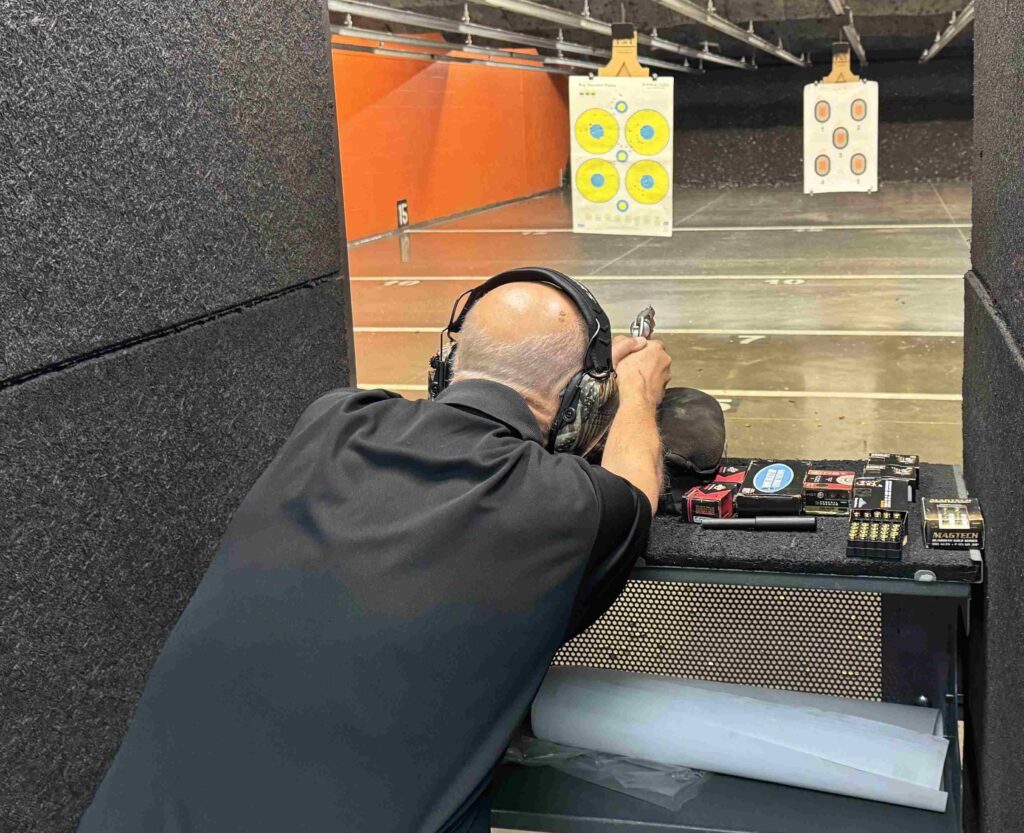
An accuracy evaluation was done at 10 yards, shooting single action, from the bench, using a sandbag rest.
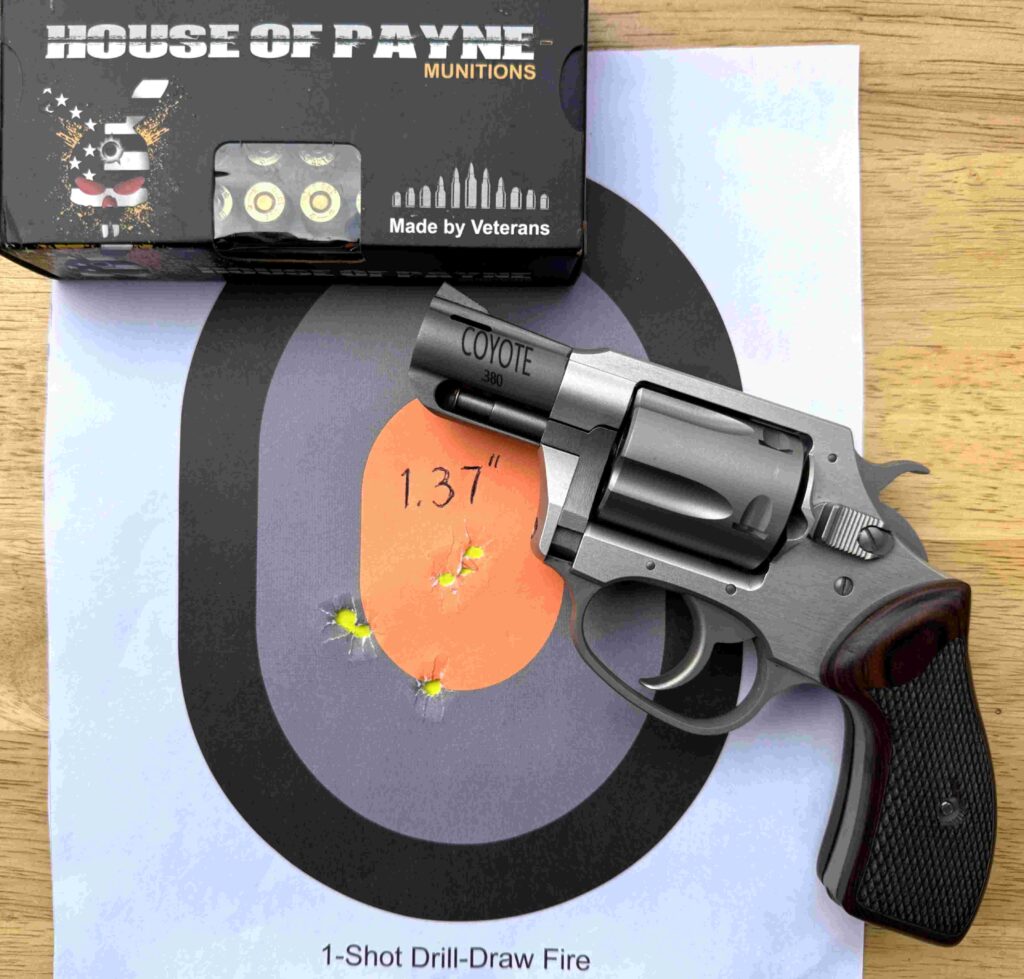
The best 5-shot group with the Coyote was made using the HOP 95 gr. FMJ load, and measured 1.37-inches.
Although the drill was made for a sixgun, I had a 5-shooter, so I modified it somewhat. The first stage is at 15 yards, all rounds (in my case 5) are fired freestyle; par time is 12 seconds (I cut this to 10). At 10 yards, 5 more shots, with a par time of 8 seconds (I did 6). At 5 yards, 5 more shots, with a par time of 4 (I did 3) seconds. Each stage is shot beginning from the low ready. I used the timer on my iPhone; the alert-tone going off at the end of the set time. “Freestyle” for me was an isosceles stance, with a two-handed hold. I held the phone close, hit the start-button on the timer, then engaged the target. I used a B-27NC silhouette, with black and gray scoring rings, and a red X-ring. When I’d completed all three stages, I was surprised to find that I’d made 100% on the drill, with 150/150-7X’s, all within par time. I had used the HOP 95 gr. FMJ load, and reloaded between stages.
Only the Facts
During the accuracy testing, I found the Coyote generally shot low and left. I had to change my point-of-aim (POA), putting the front sight at about 9 0’clock, a few inches above the oval targets, to get center hits with the lighter-bullet loads. The heavier bullets had a better POA/point-of-impact. It’s hard to say if barrel ports helped, but I found that with most of the .380 ACP loads, recoil and muzzle flip were reasonable. Shooting .38 Special loads in a revolver of this weight would be a different story. Most small revolvers like the Coyote scrape my thumb joint with the cylinder release latch. I noted that the grips/stocks on the Coyote are a bit wider than those on older Charter revolvers. They fit my hand quite well and enhanced controllability. The checkering is effective without being abrasive.
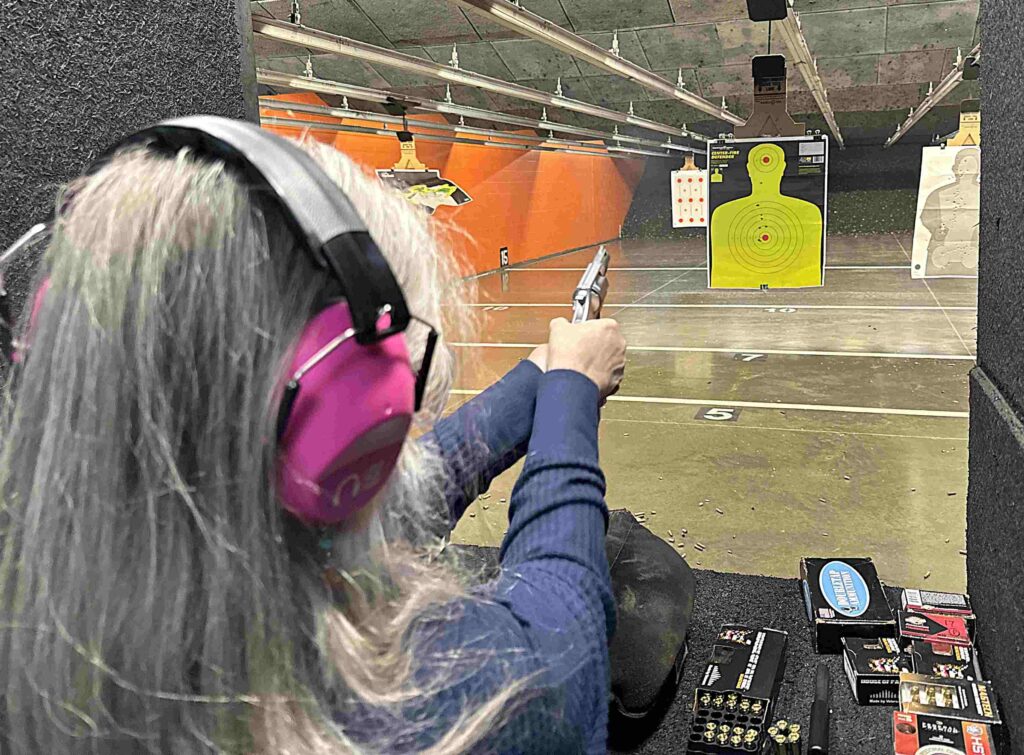
My wife Teresa had dry-fired the Coyote and wanted to try it at the range; you can see the little revolver in full recoil, which she felt was tolerable.
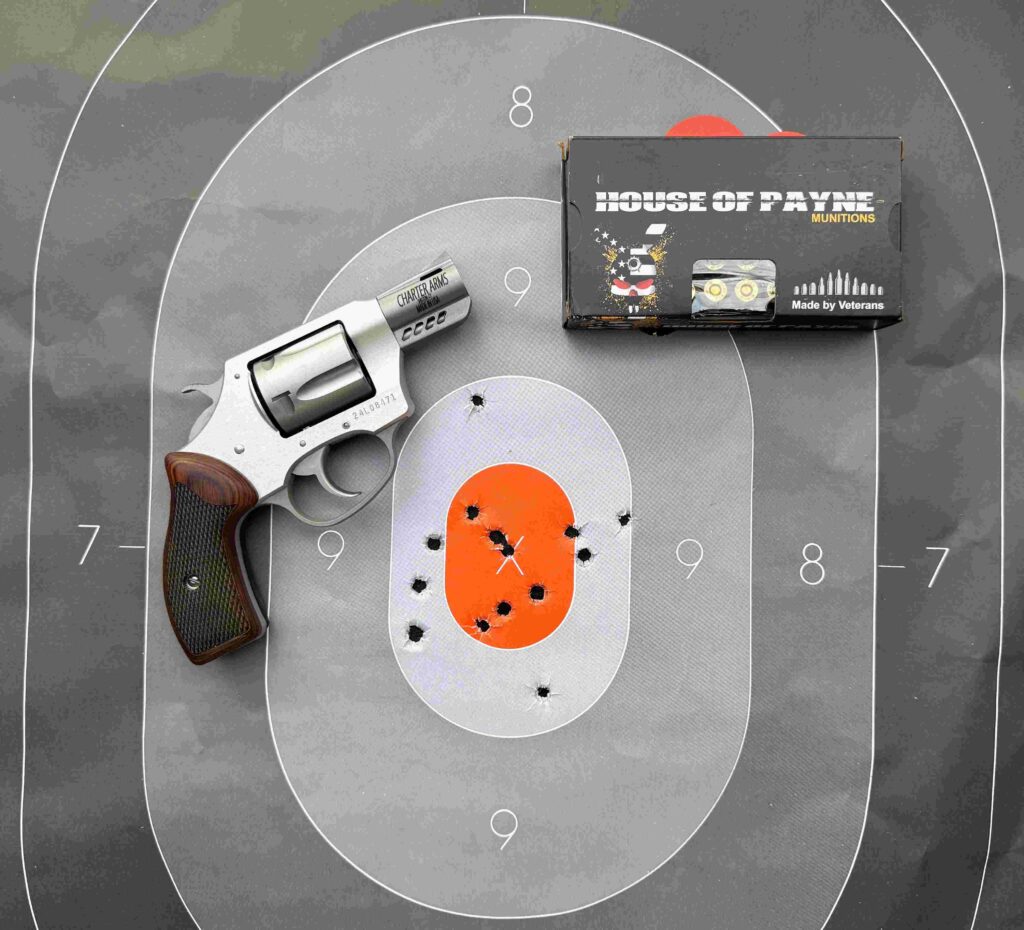
To check reliability and rapid-fire controllability, I fired a “Super Revolver Test” drill; a timed exercise, shot at 5,10, and 15 yards; I scored 100%.
Loading was fast and easy with all the .380 ACP cartridges, and ditto for case ejection. I do think Charter Arms should supply more than just two moon clips as I was paranoid through the whole test session that I’d lose one. Sight acquisition was good, but a dab of yellow fingernail polish on the front sight would help. I was most impressed with the performance of the Coyote (and my shooting) during the Super Revolver Test Drill, and this sums up all that I’ve said about the Charter Arms Coyote. While the .380 ACP is not usually thought of as a manstopper; as you can see by the muzzle energy figures in the performance table, it does allow better rapid-fire controllability for folks who might not be able to handle a more potent round due to recoil and muzzle flip.
Further Information
Charter Arms www.charterfirearms.com
Charter Arms Coyote (53803) Specifications
MECHANISM: Traditional double action revolver
CALIBER: .380 ACP
CAPACITY: 5 cartridges
BARREL: 2.0”
OA LENGTH: 6.22”
EMPTY WEIGHT: 14 oz.
SIGHTS: Fixed square-notch rear sight, serrated ramp front sight
FINISH: Clear anodized frame, matte stainless barrel/cylinder
STOCKS: Checkered rosewood
MSRP: $448.14
Charter Arms Coyote .380 ACP Performance
| Cartridge | Ave. Velocity | Best Grp. | Ave. Grp. | Ft-Pounds Muzzle Energy |
| Black Hills Factory New 60 gr. Honey Badger | 1,184 FPS | 1.93” | 2.16” | 187 FPE |
| Doubletap 80 gr. Barnes TAC-XP Solid Copper HP | 943 FPS | 1.76” | 2.09” | 158 FPE |
| Federal Personal Defense Micro 99 gr. HST-JHP | 865 FPS | 1.56” | 2.63” | 164 FPE |
| HOP Munitions 90 gr. JHP | 1,119 FPS | 1.95” | 2.17” | 250 FPE |
| HOP Munitions 95 gr. FMJ | 967 FPS | 1.37” | 1.48” | 197 FPE |
NOTE: Bullet weight measured in grains, velocity in feet per second 10 ft. from the muzzle by an Oehler Model 35P chronograph, and accuracy in inches for three 5-shot groups at 10 yards. FPE based on bullet weight and velocity.
To locate a dealer near you visit www.lipseys.com/dealerfinder

